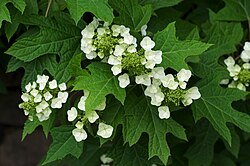Description
Hydrangea quercifolia is a coarse-textured deciduous shrub growing to 3–12 feet (0.91–3.66 m) [3] tall with an open crown. The plant sprouts shoots from underground stolons and often grows in colonies. Young stems are covered in a felt-like light brown bark, and the larger stems have attractive cinnamon-tan-orange bark that shreds and peels in thin flakes.
The leaves are yellowish green to dark green on top and silvery-white underneath. They have three, five or seven pointed lobes and are 4–12 in (10.2–30.5 cm) long and almost as wide. They vaguely resemble larger versions of oak leaves, similar to Quercus species with lobed foliage. Plants in shade have larger leaves than those grown in sun. The leaves turn rich shades of red, bronze and purple in autumn that persist in winter accompanying the persistent dried flower-heads.
Flowers
Hydrangea quercifolia flowers are borne in erect panicles 6–12 in (15.2–30.5 cm) tall and 3–5 in (7.6–12.7 cm) wide at branch tips. Flowers age in colour from creamy white, aging to pink and by autumn and winter are a dry, papery rusty-brown.
Unlike bigleaf hydrangea (Hydrangea macrophylla), flower color does not vary with soil pH. Flower color does, however, vary throughout each growing season. The flowers are a pale green as they emerge and open to a bright white, ageing to either pink or brown (depending on the cultivar/seedling). [4]
Hydrangea quercifolia and Hydrangea paniculata are the only hydrangeas with cone-shaped flower clusters (i.e. panicles); all the others have their flowers in ball-shaped or flat-topped clusters, called umbels. [5]
Like many other Hydrangea species, oakleaf hydrangea inflorescences are composed of two flower types; showy flowers with enlarged petal-like sepals and inconspicuous flowers with non-showy petals and sepals. [4] The showy flowers, whose function is to attract pollinators, typically obscure the inconspicuous flowers to some degree.
Although faint, Hydrangea quercifolia flowers have a pleasing scent. The floral scent in oakleaf hydrangea is stronger than that of the other commonly cultivated Hydrangea species. [4] Presumably the function of the floral scent is to attract pollinators, although this has not yet been studied. The fragrance can be described as being most similar to Syringa reticulata (Japanese tree lilac), although not as strong.
Fruit
The fruit of Hydrangea quercifolia are dry dehiscent capsules which are green following pollination and ripen to brown as they mature. The stigmas remain on the fruit and dry to form horn-shaped appendages atop the capsule with an opening between them to allow the seeds to disperse. [4]
Seeds
Hydrangea quercifolia seeds are quite small, approximately 0.6 mm long [6] (and with a thousand seed weight of 0.0356 g [7] ) allowing several to develop within each capsule. Seed color varies from light tan to dark brown with longitudinal striations. Seed shape is ellipsoidal to ovate. Seed storage behavior is considered to be orthodox in nature, [7] allowing them to store for relatively long periods of time at cold temperatures. The seeds typically germinate readily in 7-14 days as long as they are not allowed to dry out after sowing.
Distribution
Hydrangea quercifolia is native to the south eastern United States (Alabama, Florida, Georgia (w.), Louisiana (e.), Mississippi, North Carolina, South Carolina, Tennessee), but naturalized in other parts of the US and widely cultivated elsewhere.
In nature, Hydrangea quercifolia is found in a variety of habitats but almost always on well drained, shady slopes. These include riverbanks, bluffs and rocky outcroppings. The tendency of the species to grow on calcareous soils or cliffs as well as deep alluvial soil suggests it has a wide tolerance of soil substrates as long as they are well drained. [8] [4]
This page is based on this
Wikipedia article Text is available under the
CC BY-SA 4.0 license; additional terms may apply.
Images, videos and audio are available under their respective licenses.









